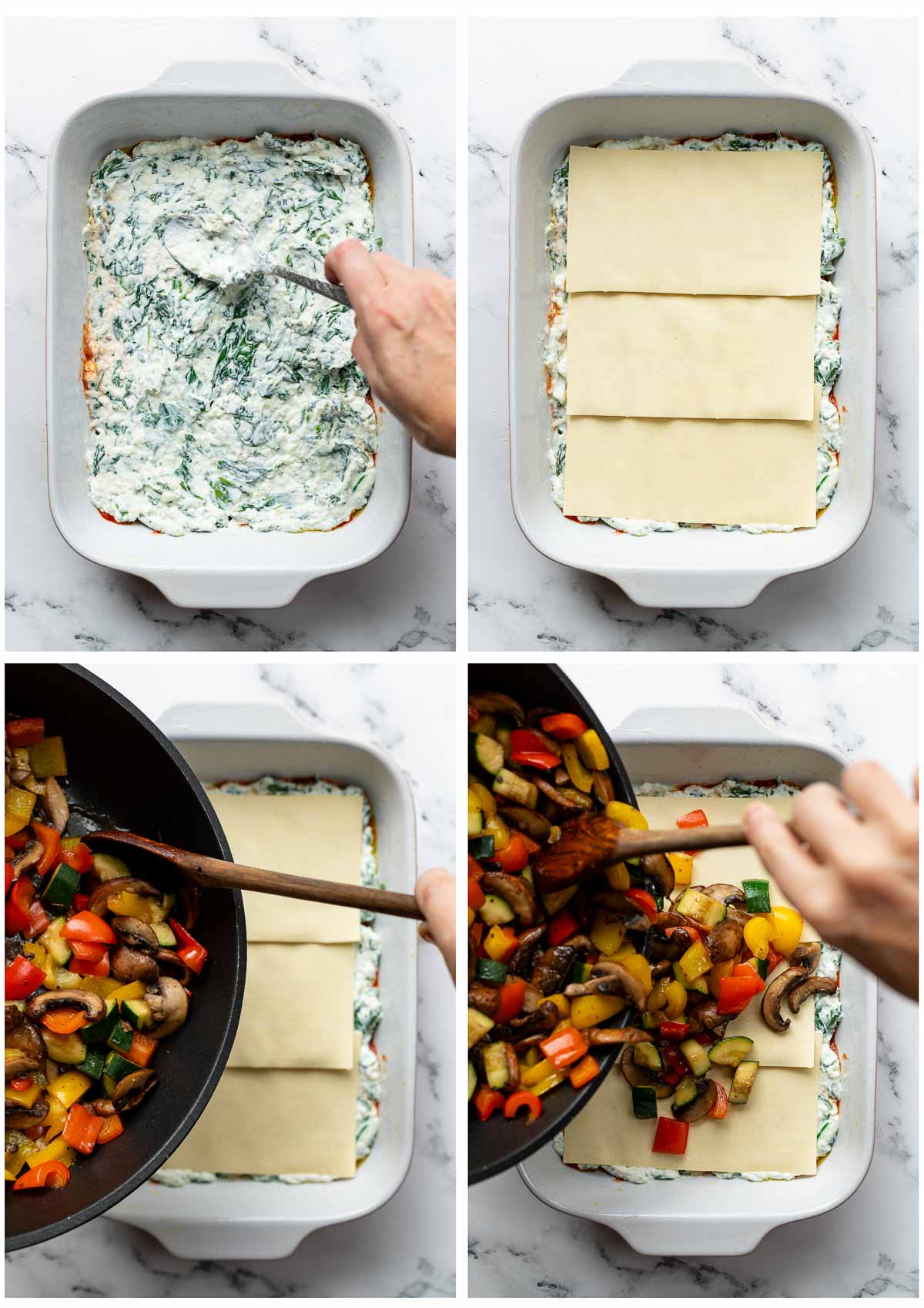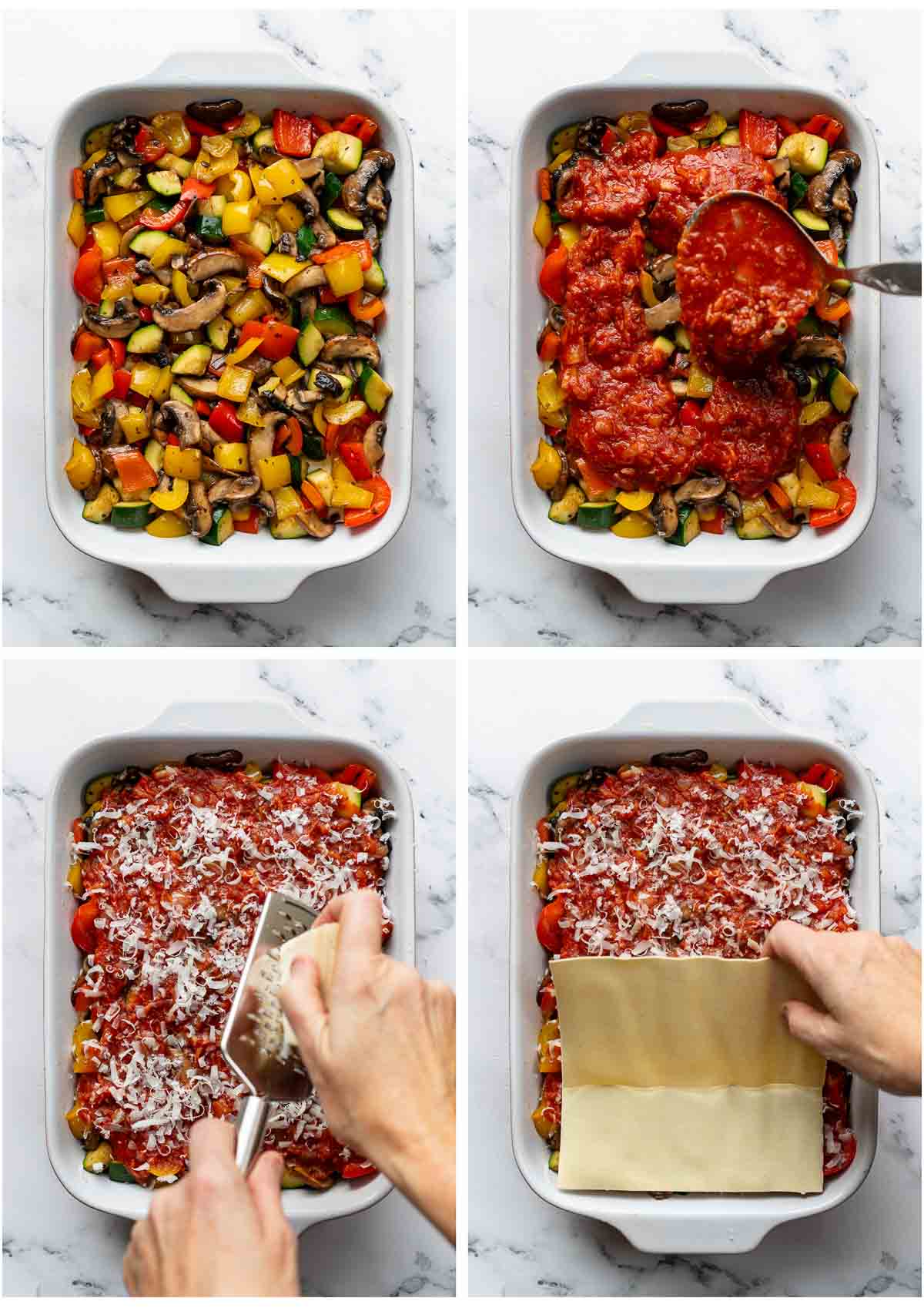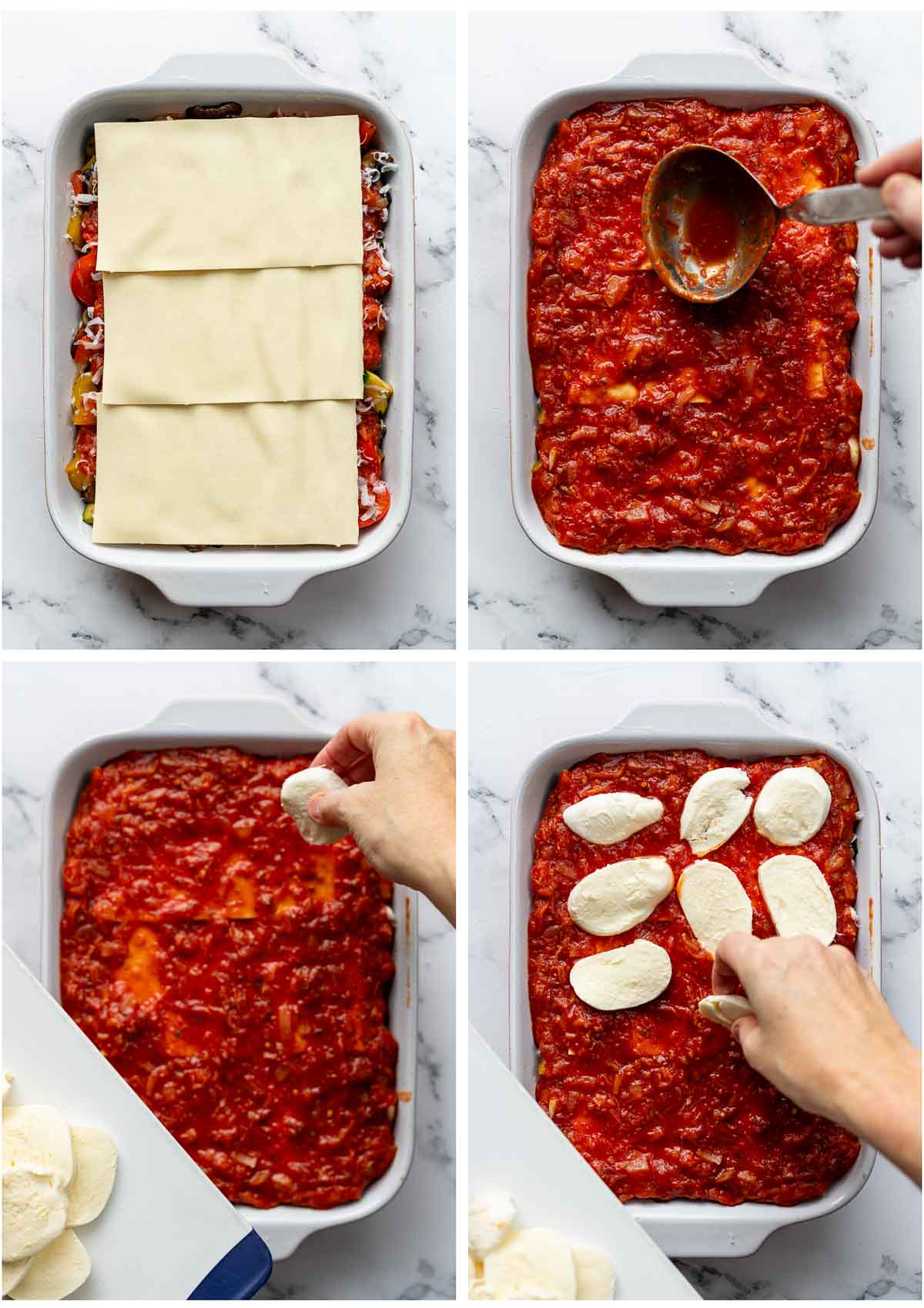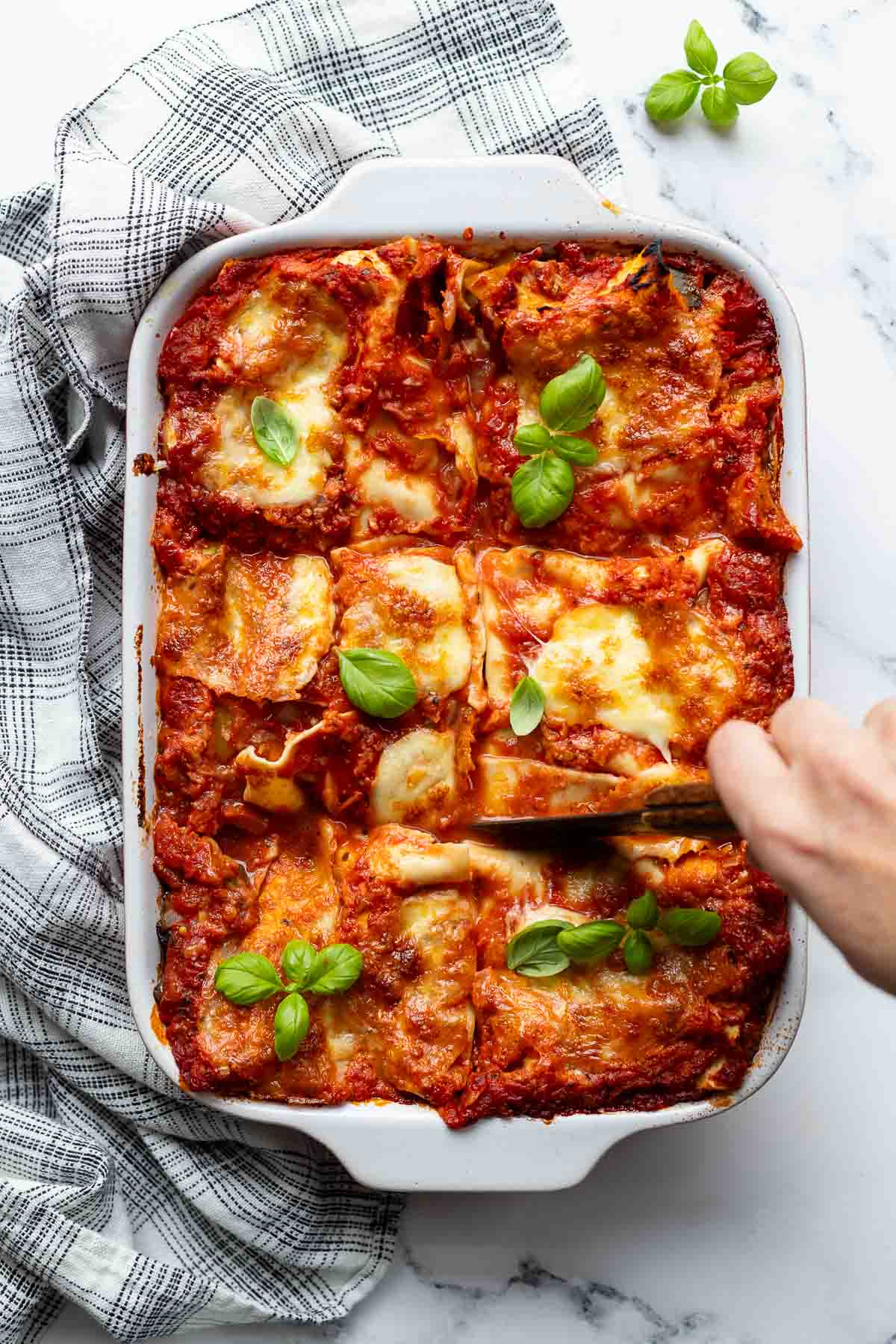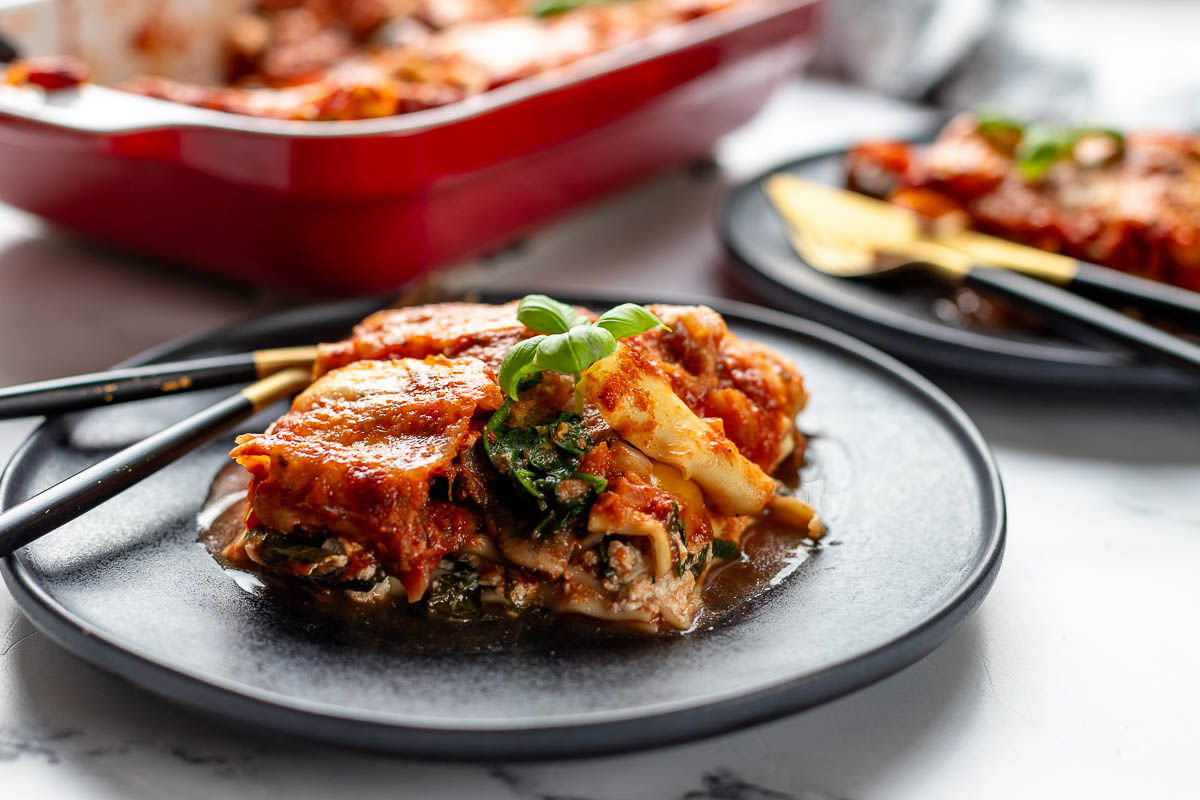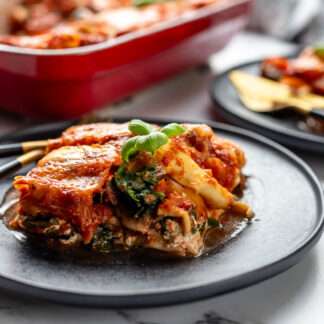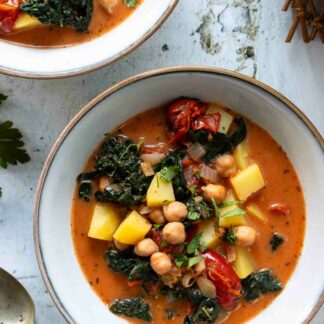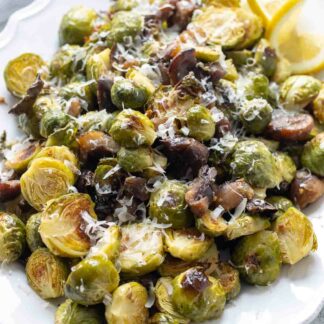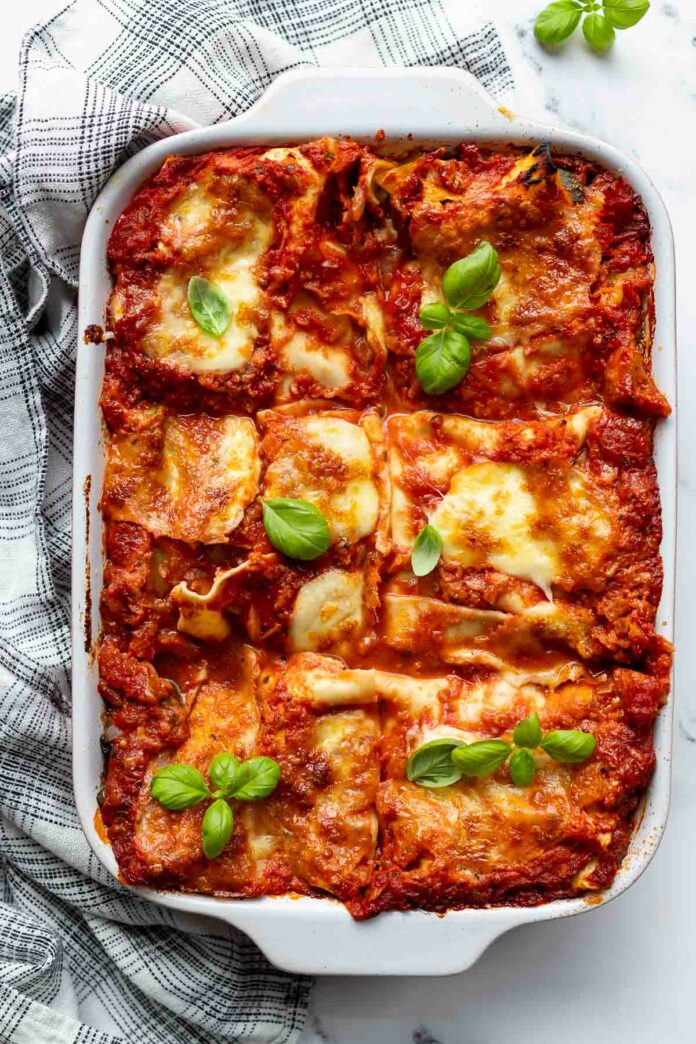
This vegetable lasagna recipe is a family favourite! It’s filled with a savoury layer of sautéed vegetables, spinach and ricotta, a simple tomato sauce, and a cheesy topping. It’s healthy, delicious and easy to make! Plus there are lots of ways you can adapt it to use the ingredients you already have on hand.
Yes, everyone loves a comfort food lasagna, right? It’s a great way to feed a crowd if need be, and reheats well. So, leftovers can keep you happy for days. And the fantastic thing is that you can pretty much use any vegetables you have on hand. I like to stick to “Mediterranean vegetables” such as sweet peppers and zucchini, plus mushrooms for their extra umami savouriness. But that’s not it! You’ll find grated carrots in the sauce, plus onion and garlic, and then there is a layer of spinach mixed with ricotta and parmesan. Yes, veggie packed, but still tastes decadent enough to satisfy.
The ingredients
Here’s what you’ll need to make this vegetable lasagna recipe, along with ingredient notes and substitutions:
Oven ready (no boil) lasagna noodles
Since there are already a number of steps in preparing this vegetarian lasagna recipe, it makes sense to use oven-ready, no-boil lasagna noodles. With these type of noodles, there is no fuss with pre-boiling, draining and drying them out. Plus no boil lasagna sheets are the best choice for a vegetable lasagna since they will soak up the extra moisture from the vegetables as the lasagna cooks in the oven.
A medley of vegetables
In this vegetable lasagna recipe, you’ll find sweet bell peppers (red and yellow), zucchini and cremini mushrooms. All of which give the lasagna substance, making it hearty, as well as giving it lots of flavour. I like to use mushrooms in this recipe, as they are a fantastic stand-in for meat. I chose to use cremini mushrooms, however you could use another type or try a mix of cremini, shiitake and king oyster for more depth of flavour. Or…you could trade out mushrooms for eggplant and add some red onion.
Other vegetables to try
leeks, celery, butternut squash, sweet potato, cauliflower, broccoli. Just be sure you have about 400-450 g diced vegetables that are roasted or cooked until tender before layering in the lasagna.
Spinach (fresh or frozen)
I like to use baby spinach or young leaf spinach and lightly blanch it. Using frozen spinach would be a quick and easy alternative. Just ensure that it is fully thawed and that the excess moisture is squeezed out (as with the blanched spinach as well). You could also replace it with blanched curly kale or Tuscan kale.
A simple but flavourful tomato sauce
I like to keep the tomato sauce quite simple, but also add some extra flavours from onion, garlic, carrot, herbs and a pinch of chili flakes. Of course, you could short cut this by using a store-bought ready made sauce, such as marinara (or make it yourself, it’s easy). Alternatively, you could change things up and make a simple Mediterranean style homemade tomato sauce with onions, garlic, chili, kalamata olives, capers, and basil. Maybe even some sun-dried tomatoes, or chopped fresh tomatoes for extra flavour.
Three types of cheese
Ricotto, parmesan, mozzarella. A layer of ricotta cheese mixed with parmesan and spinach is used to create a layer of creaminess. You can substitute cottage cheese for the ricotta, if desired. Parmesan simply makes everything taste better. It infuses the lasagne with an enticing salty, nutty taste. A melty cheese like fresh mozzarella tops the dish, however it could be replaced with your favourite melty cheese, such as a Gouda, Edamer, Emmentaler or even French Comté.
How to make a vegetable lasagna
For this recipe, we are essentially preparing three components before layering the lasagna noodles in a casserole. Here’s the run-down:
Step 1: Prepare vegetable sauce
Start by making the tomato sauce. It will simmer for 20-25 minutes to allow the flavour to develop and infuse. This will give you time to prepare the rest of the fillings.
Step 2: Sauté the vegetables (or roast them!)
While the sauce simmers, you’ll have time to chop the vegetables and sauté them until tender before layering them in the lasagne.
Step 3: Prepare spinach-ricotta filling
Stir together the ricotta, parmesan and spinach. This will give the lasagna a layer of creamy decadence.
Step 4: Layer vegetable lasagna and bake
From here it’s just an assembly job. Some sauce, a layer of noodles, a layer of the spinach-ricotta mixture, more noodles, load them up with the vegetables, more sauce, followed by a layer of cheese. That’s it! Bake until the cheese is golden brown and sauce is bubbly and then you’re ready to eat!
Roasting versus sautéing the vegetables
For this vegetable lasagna recipe, you can also roast the vegetables rather than preparing them in a skillet. This might be a good idea if you decide to swap some of the ingredients out for a different type of vegetable, such as sweet potato or butternut squash. To roast the vegetables: place them on the baking sheet lined with parchment, drizzle with oil, sprinkle with salt and pepper. Toss. Roast for 20-25 minutes, turning at 10 minutes, until tender and lightly browned.
The best vegetable lasagna
Here are a few reasons to love this recipe:
- You can easily adjust the type of vegetables to suit the season or to what you already have on hand (see tips above).
- The sauce is homemade but made with basic, simple ingredients. Meaning it’s quick and easy to prepare.
- No-boil noodles means less work. All you have to do is layer them!
- Although lasagna might not be the quickest weeknight option, it is a reasonably simple to make.
- The end result is a nutrient-dense, veggie-packed lasagna that is delicious, filling and satisfies all your comfort food cravings.
Questions and answers related to this vegetable lasagna recipe
Why is my lasagna watery?
There are a couple of reasons why your vegetable lasagna may be watery.
- Watery spinach. If you choose to use frozen spinach, it is important to drain it and squeeze it VERY dry before using it in this recipe. The moisture should also be gently pressed out of blanched fresh spinach.
- Too much moisture from the vegetables. When sautéing the vegetables, they excess moisture should be cooked off. You may see more moisture when you season the vegetables with salt and pepper. This is fine, simply try to avoid adding the extra juices to the lasagna when assembling it.
- A watery sauce. The simmered tomato sauce should be thick when adding it to the lasagna. If you thin it down with too much water, this will also result in a watery lasagna.
- Cooling time. As tempting as it is, let the lasagna cool for a few minutes prior to cutting into it. It needs time to set and firm up, this happens as it cools as the liquids are reabsorbed and the layers come together. Otherwise, you might have a sloppy mess when you try serving it.
How long can you store leftover vegetable lasagna?
The vegetable lasagne tastes almost even better the next day. It will keep in the fridge, covered, for 3-4 days.
Can I reheat vegetable lasagna leftovers?
Half the pleasure of making a lasagna is enjoying the leftovers! You can warm the whole casserole (covered with foil) in the oven at 350°F/180°C for about 20 minutes. I find letting it stand at room temperature beforehand helps speed up the reheating time. And of course, if you are taking individual slices to work, use a microwave.
Can I freeze vegetable lasagna?
Freeze leftovers in an airtight freezer-safe storage container for up to 3 months. Let thaw overnight in the refrigerator before reheating.
Looking for other comfort food meal ideas?
Try one of these favourites for the whole family:
- Simple Chicken Potato Soup
- Moroccan Spiced Lentil Pie with Sweet Potato
- Pasta con Salsiccia with Creamy Tomato Sauce
- Creamy Mushroom Gnocchi with Spinach
Easy Vegetarian Lasagna
Easy vegetable lasagna recipe filled with a layer of sautéed vegetables, spinach and ricotta, a simple tomato sauce, and a cheesy topping.
Ingredients
For the sauce:
- 1 tablespoon olive oil
- 3 large garlic cloves, minced
- 2 small yellow onions, finely chopped
- 1 medium carrot, grated
- 1 x 680 g jar tomato passata (pureed strained tomatoes), plain or with basil
- 60 ml water (use to rinse jar)
- 1 large bay leaf
- 1/2 teaspoon dried thyme
- 1 teaspoon dried oregano
- 1/2 teaspoon chili flakes, or to taste
- Sea salt and freshly ground pepper, to taste
For the vegetable layer:
- 2 tablespoons olive oil
- 200 g cremini mushrooms, sliced
- 2 bell peppers (red and yellow), cut into 2,5 cm dice (approx 300g)
- 1 medium zucchini, cut into 2,5 cm dice
- Sea salt and freshly ground pepper, to taste
For the spinach-ricotta layer:
- 100 g spinach, blanched and chopped (see tips below)
- 250 g Ricotta
- 50 g freshly grated Parmesan
- Sea salt and freshly ground pepper, to taste
To assemble the lasagne:
- 9 no-boil lasagne sheets (145 g) - see tips below
- 3-4 tablespoons freshly grated parmesan, divided
- 2 x 100 g package fresh mozzarella, thinly sliced
Method
Prepare the sauce:
-
In a medium saucepan, heat 1 tablespoon oil over medium heat and sauté the onions, garlic and carrots until softened (5-6 minutes). Add the tomato passata, water, bay leaf, thyme, and oregano. Season with salt and pepper and bring to a simmer. Reduce the heat to a low simmer and cook for 20-25 minutes, in oder for the flavours to deepen and develop, stirring occasionally, until thickened. Taste and adjust seasoning with more salt, if needed. Discard bay leaf.
Prepare the vegetable filling:
-
Meanwhile, using a large non-stick skillet, heat 2 tablespoons olive oil. Add the mushrooms, bell peppers and zucchini. Cook on medium-high to high heat for 8-10 minutes, stirring often, until vegetables are tender and moisture has cooked off. Season with salt and pepper.
Prepare the spinach-ricotta filling:
-
In a bowl, mix together the blanched spinach, ricotta, and parmesan. Set aside until ready to use.
Assemble the lasagna:
-
Preheat oven to 430°F / 220°C (200°C fan-assisted).
-
Brush the base and sides of a large baking dish (28 cm x 22 cm or 2.2 liter) with olive oil. Spoon 1,5 ladleful of the sauce (1/2 cup / 125 ml) over the base and spread it out into an even layer. Layer 3 lasagna sheets on top (overlap their edges as necessary).
-
Spread spinach-ricotta mixture evenly over the noodles. Top with 3 more lasagna sheets.
-
Add the sautéed vegetables and spread them out in an even layer. Add 3 ladles of sauce (about 1 cup / 250 ml, or a little more than half of the remaining sauce) and spread it over the vegetables. Sprinkle with 2 tablespoons grated parmesan. Top with 3 more lasagna sheets.
-
Add the remaining sauce on top (there should be 2 ladles full left) and spread it out evenly on top, making sure the whole surface is covered. Scatter over the mozzarella and sprinkle with a little grated parmesan.
-
Bake for about 30 minutes until bubbling and cheese is golden. You can check if it is done by sticking a knife in the middle — there should be no resistance. If it needs longer, place back in the oven for 5 more minutes (covering with foil, if needed).
-
Rest for 5-10 minutes before cutting and serving. Enjoy!
Rezept Video
Notes
- Using frozen spinach: If you are using frozen spinach, make sure to thaw it fully and squeeze out all the water before using.
- Using fresh spinach: If using baby spinach, place it in a colander, pour boiling water over it, then rinse with cold water. Gently press out excess water. For leaf spinach, place the leaves in a pot of boiling water for 30-60 seconds, then transfer to a bowl of ice cold water. Drain and gently squeeze any remaining water out before using.
- Lasagne noodles: If you prefer even more pasta in your lasagne simply overlap 4 sheets of lasagne noodles for each layer rather than 3 sheets.
- Make ahead: You can assemble the lasagna and refrigerate it for 2-3 hours prior to baking it.
- Storing: The lasagna keeps well, covered, in the refrigerator for 3-4 days. Simply reheat in the oven at 350°F / 180°C for 15-20 minutes before serving.
- For more tips, see above.
For a relaxing atmosphere in the kitchen I recommend my personal Elle Republic: Chilled Out Kitchen Tunes Playlist on Spotify.




